
How To Offer Free Gift or BOGO At Shopify Checkout?
Offering free gifts directly at checkout is a powerful last-minute conversion strategy that can increase average order value and...
![[2025] Shopify Furniture Stores: A Detailed Guide to Build a Successful Furniture Business](https://bogos.io/wp-content/uploads/2025/02/SHOPIFY-FURNITURE-STORE-2.jpg)
Digital Marketing Specialist
The furniture store market for 2025 will exhibit exceptional growth, with current trends of sustainable designs combined with innovative furniture and bold aesthetics. E-commerce growth has reached its peak, so beginning an online furniture business presents a unique business opportunity.
More consumers prefer shopping online, causing Shopify furniture stores to expand. Shopify has become the top platform due to its simplistic setup, beautiful design features, and robust functionality.
This blog guide will explain how to develop adequate Shopify furniture stores by selecting proper themes and implementing apps that boost marketing performance. The guide also introduces real-world case studies and practical tips for forming a memorable retail outlet in 2025.

What began as a small idea among seven Canadian friends became a global success, but scaling internationally wasn’t easy. Slow site speeds and a lack of localization tools made it difficult for Shopify furniture stores like Transformable Table to reach customers worldwide.
After switching to Shopify Plus, their site speed jumped by 67%, keeping mobile shoppers engaged, while Shopify’s Translate & Adapt app helped them tailor content for different markets. With automated currency conversion, global sales became effortless, making up 20% of total revenue.
“Within one day of switching, we saw better results than we’d ever seen on Wix,” says co-founder Artem Kuzmichev. Today, Transformer Table generates over $100 million annually, proving that the right platform makes all the difference.
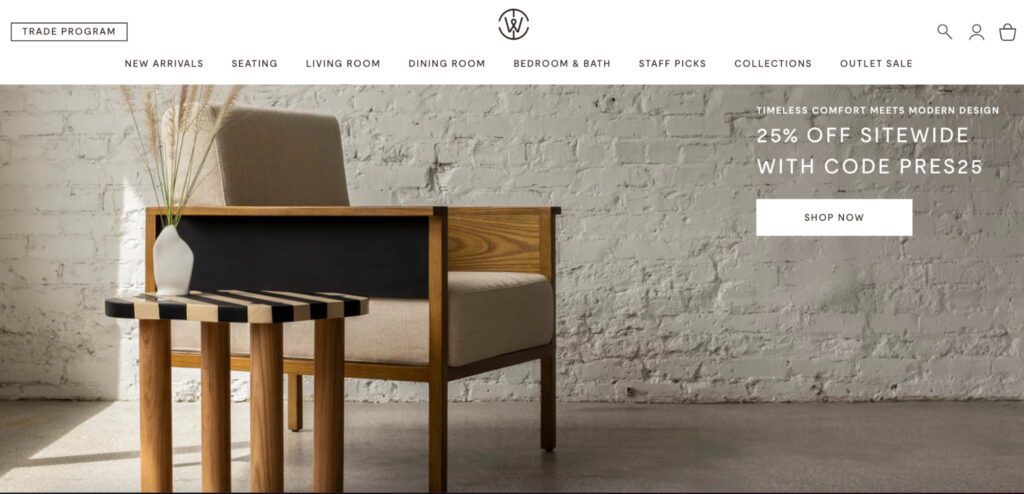
Based in America, Industry West is a premium furniture brand that selects luxurious, distinctive items for corporate and personal clients. Jordan and Anne England founded this brand in 2012. The platform they previously used, called Magento, restricted the company through a problematic administration area and restricted customization capabilities.
The main business hurdle Industry West needed to solve involved developing a unified online platform that displayed its premium design approach but fulfilled the complicated requirements of its B2B clientele. Shopify allowed Industry West to solve these issues and generate exceptional outcomes, making it one of the standout Shopify furniture store examples in the industry, including:
With Shopify, Industry West was able to streamline its backend operations and reduce admin tasks, ultimately driving growth, revenue, and customer satisfaction.
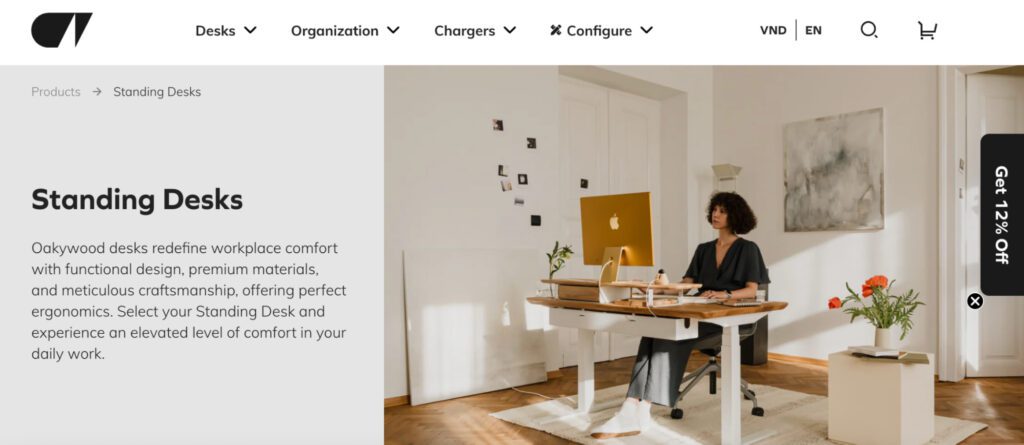
Oakywood is a Polish online furniture manufacturer that merges traditional woodworking practices with contemporary technology to deliver sustainable office items and accessories. Similar to other Shopify furniture stores, it faced challenges in expanding its brand scope from online marketplaces, including Etsy. However, the lack of ownership and customization options hindered their growth.
By migrating to Shopify Plus, Oakywood overcame these challenges and achieved remarkable results, including:
With Shopify Plus, Oakywood leveraged the app ecosystem to streamline custom orders and enhance the customer experience. The combination of Shopify AR and Precismo’s 3D scanning technology enabled customers to see their customized products ahead of time, thus improving order volume.
The international sales tools of Shopify also allowed the brand to undertake global expansion while remaining able to sell across multiple countries using different currencies.

Life Interiors, a design-led furniture retailer, wanted to achieve $100 million in revenue, yet their aging e-commerce system limited their progress. The company invested six months into redeveloping its platform into Shopify Plus to achieve scalable efficiency, supporting its growth objectives.
The results were impressive, with significant performance improvements just two months after migrating. The brand used Shopify Plus’s Draft Orders feature to enhance product ordering operations, which shortened processing time and generated more customer transactions.
Basil Karam, CEO and Co-Founder at Shopify, states, “Shopify Plus is a specialist and best-of-breed in the e-commerce and retail omnichannel industry. As a direct-to-consumer brand, Shopify Plus empowers us to achieve our ambitions and our vision, as well.”
Of all the Shopify furniture stores, the innovative setup of Life Interiors distinguished itself through Shopify Plus’s efficiency capabilities. The updated business approach positions the brand to achieve its revenue aims while delivering fashionable contemporary furniture to fashion-forward Australians.
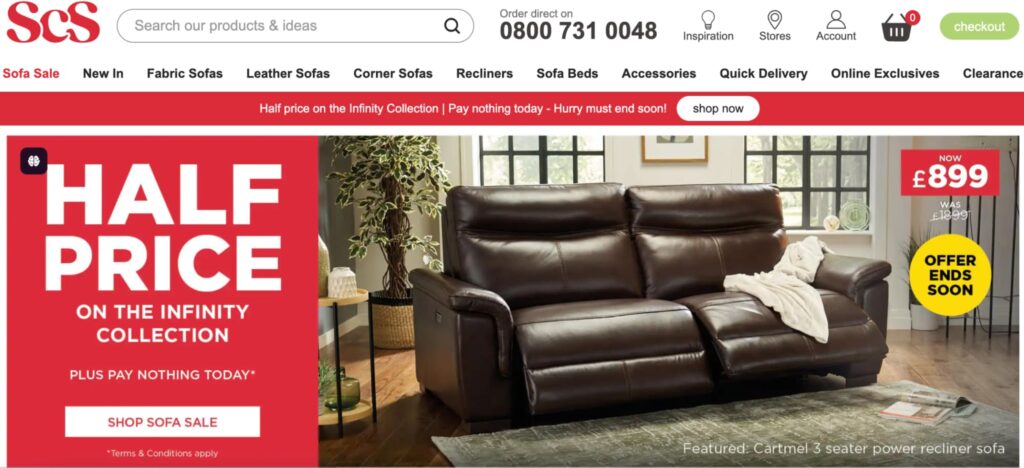
The innovative furniture company Snug struggled to sell its sofa-in-a-box modular furniture offering through online channels. They then moved to Shopify Plus in 2018 and utilized social commerce methods and modern technology to create deep customer interactions. By integrating apps like Gorgias and ConferWith, Snug enabled customers to view sofas in virtual showrooms and connect with experts online.
The results were staggering, with Snug experiencing a 10X increase in revenue growth since migrating to Shopify Plus. As Founder and CEO Rob Bridgman notes, “Shopify Plus enabled us to migrate to a more sophisticated and stable tech stack with apps that enable our virtual showrooms.” This move freed up time for the team to focus on new channels like social commerce and live selling, driving further growth and innovation.
With Shopify Plus, Snug achieved impressive results, including:
This brand is another great addition to the Shopify furniture store examples, demonstrating how technology and social commerce can drive rapid growth.
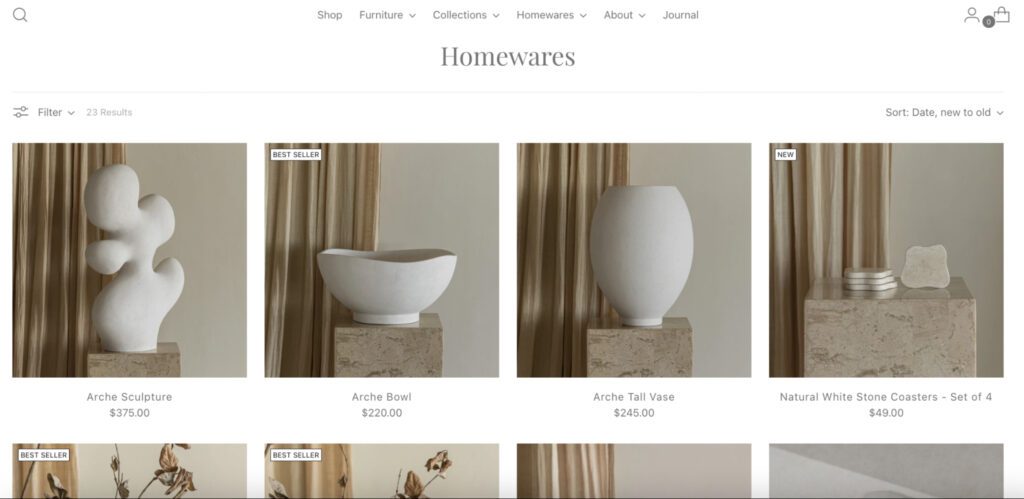
A luxury furniture company named En Gold began operations in 2018 when Steffanie and Matt Ball decided to merge Asian workshops with innovative Australian furniture concepts. Business expansion required En Gold to adopt a B2B sales model, yet it did not have the needed infrastructure for e-commerce.
En Gold enhanced its business strategy through Shopify Plus by tailoring website features and checkout systems to fulfill the needs of multiple customer types. Through checkout extensibility, the brand gained control over shipping charges to match order size, addressing money-draining issues.
Implementing Shopify Plus B2B tools allowed this brand to establish a dedicated digital storefront that served DTC and B2B clients simultaneously. En Gold expanded its B2B operations after using this platform to manage its DTC and B2B selling efficiently.
The results were impressive, with En Gold seeing:
As Digital Marketing & E-commerce Specialist Yuki Maeda notes, “What I love about Shopify is that it is constantly evolving at a rapid pace, which is evidenced by additions such as checkout extensibility.” For those looking for Shopify furniture store examples that successfully navigate both B2B and DTC, En Gold serves as a strong case study.
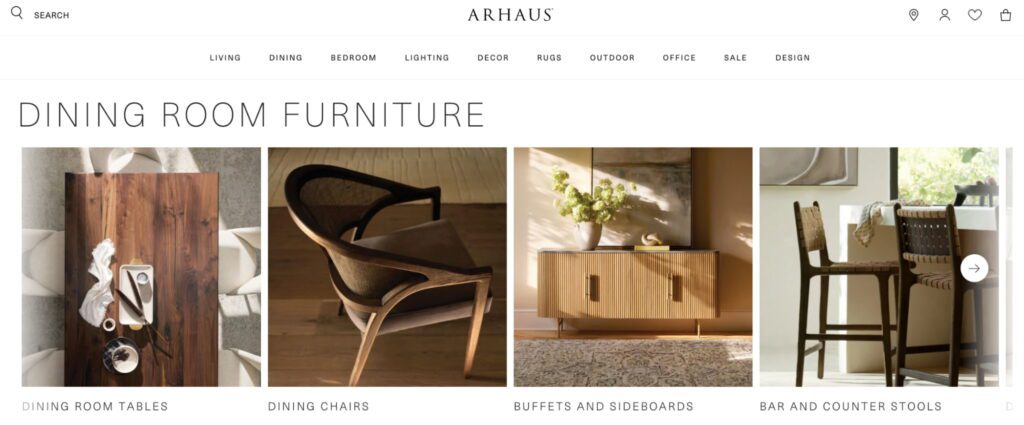
Arhaus, a US-based luxury furniture brand, has been a benchmark for premium home furnishings since 1986. With a strong focus on sustainability and craftsmanship, they’ve built a loyal customer base across their 90+ showrooms and design studios. However, their rapid growth and complex product offerings posed a significant challenge for their homegrown e-commerce platform.
Arhaus’s journey to Shopify was a strategic move to bridge the gap between their online and offline experiences. By migrating to Shopify, they aimed to create a great customer experience and improve engagement metrics. They’re excited to leverage Shopify’s emerging technologies like AR and VR to elevate their brand further.
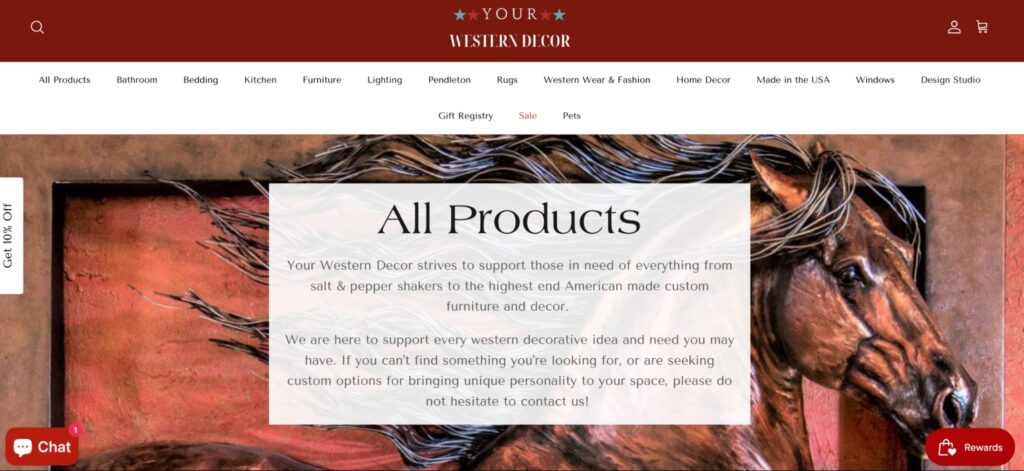
Your Western Decor, a US-based home furnishings company, was founded by Randee McKague in 2009. With her daughter Hayden, an interior designer, they provide custom western-themed furnishings and design services to clients. As the business grew, Randee faced cash flow challenges due to her reliance on traditional bank accounts, which weren’t integrated with her e-commerce business.
To overcome this, Randee switched to Shopify Balance, a free financial account built into Shopify. This move streamlined her financial operations, allowing her to access sales revenue faster and pay for large expenses quickly. With Shopify Balance, Your Western Decor:
By simplifying their finances, Randee and Hayden have been able to focus on expanding their business, including their interior design services. With Shopify Balance, they’ve reduced financial stress and gained more time to concentrate on business development and client engagement.

The e-commerce home goods company Brooklinen achieved market fame through its fluffy and breathable linen products. The company obtained authority by teaching customers about sleep science while correcting false beliefs about bedding choices.
The move to Shopify as an operating system for B2B operations enabled this brand to optimize its business functions and build customized customer buying experiences. The operational changes have freed Brooklinen staff members to enhance customer service while they no longer have to handle order management tasks.
Brooklinen succeeds through these major points:
By leveraging these strategies, Brooklinen has become a go-to destination for high-quality home goods, much like the leading brands found in Shopify furniture store examples that successfully combine education, automation, and personalization to drive growth.
To start, sign up for a Shopify account and choose a pricing plan that fits your business. Shopify offers a free trial, so you can explore its features before committing.
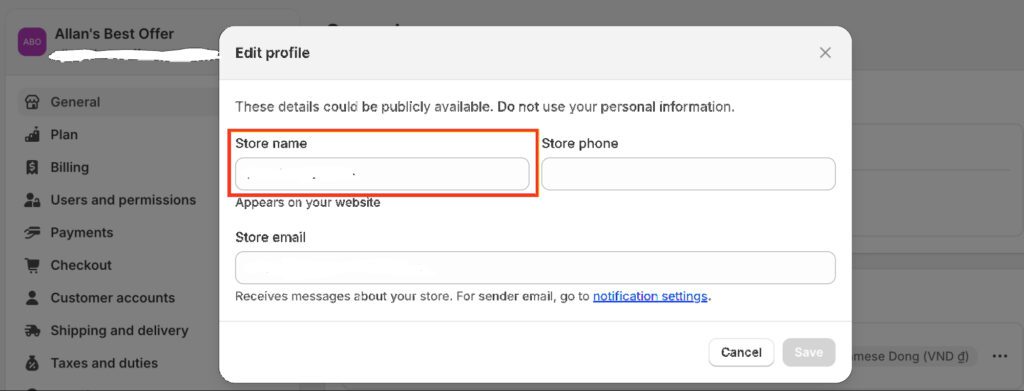
👉 Example: If you’re selling premium wooden furniture, ensure your store name reflects quality, like “Timber Luxe Interiors” instead of something generic.
Your store’s design influences customer trust and conversion rates. Shopify provides free and paid themes optimized for furniture and home decor. Choosing the right Shopify furniture store themes ensures your store looks professional, loads quickly, and enhances the shopping experience.

👉 Example: If you’re selling modern furniture, a sleek, minimal theme like “Impulse” keeps your site clean and high-end. For rustic furniture, use warm colors and textures in a theme like “Warehouse” to showcase large images.
Furniture is a visual purchase – customers want to see details before they buy. High-quality images, 360-degree views, and videos can dramatically improve conversions.
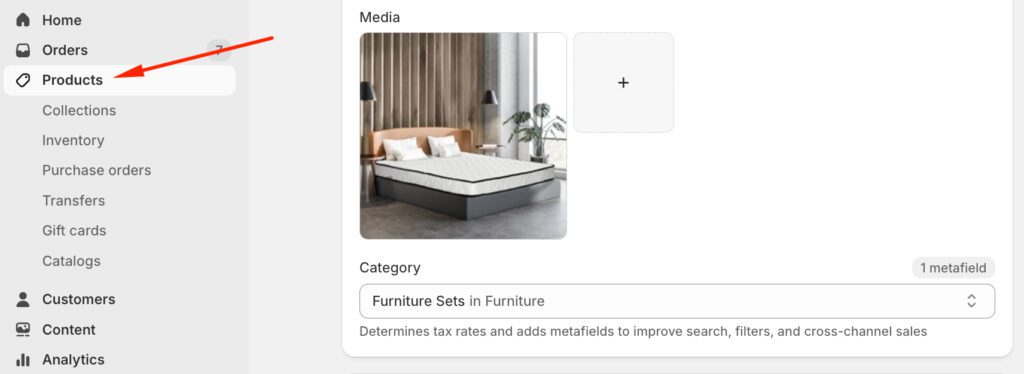
👉 Example: Instead of just showing a plain image of a sofa, display it in a styled living room with good lighting to help buyers visualize it in their own space.
Well-written descriptions help sell your furniture by providing details customers care about. You can follow this format:
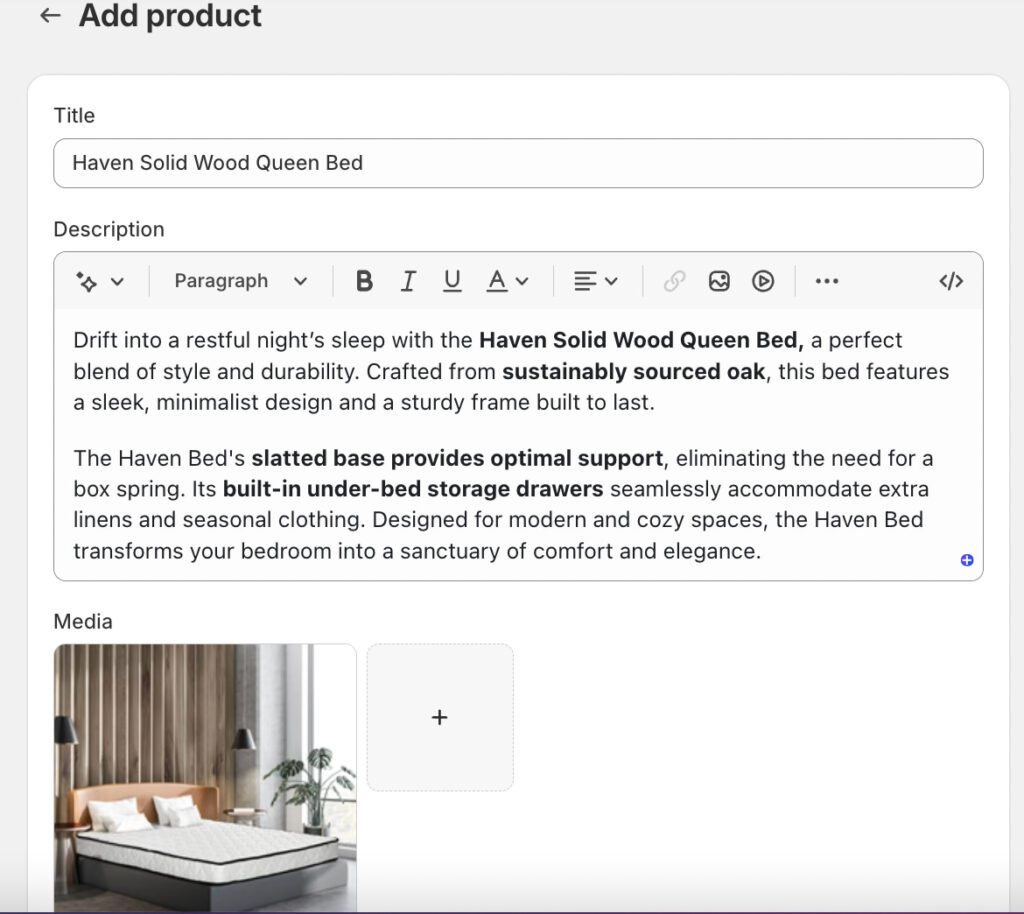
Collections organize your products and make browsing easier for customers. Let’s group furniture based on Style (Modern, Rustic, Industrial), Room (Living Room, Bedroom, Office), or Functionality (Space-Saving, Multi-Purpose, Luxury).
Follow these steps:
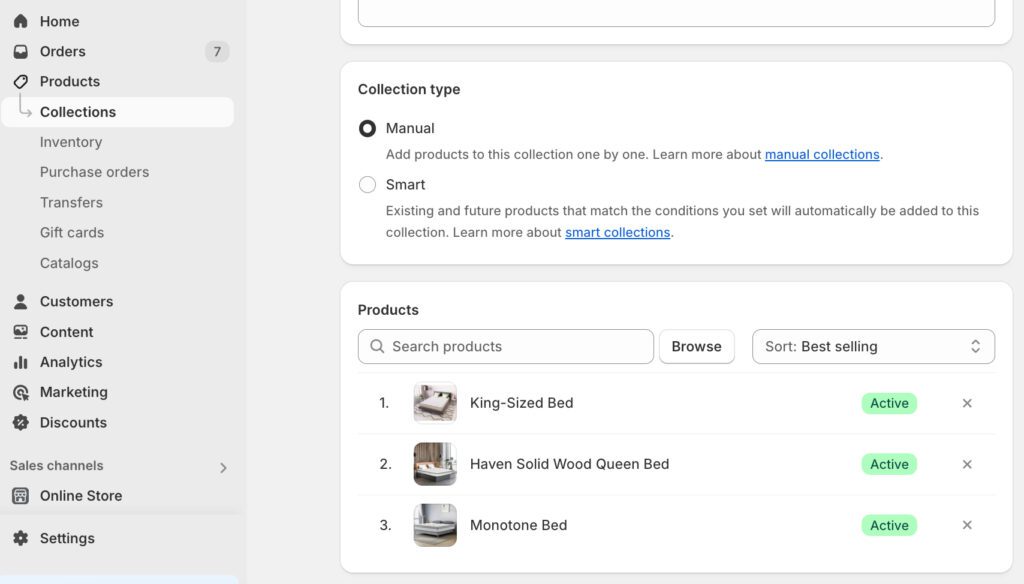
Enhance your store’s shopping experience with apps that improve conversions. Many Shopify furniture stores use:
👉 Read more: Best Shopify Apps To Increase Sales & Conversions
Your homepage is your storefront window – it needs to attract, inform, and convert.
👉 Example: If you sell luxury furniture, use a full-screen hero image of a designer living room setup with a “Shop the Look” button leading to featured products.
When Shopify furniture stores have a distinct niche, customers recognize their brand, and customer retention is improved. Instead of trying to sell every type of furniture, narrowing your focus to a specific style, material, or target audience helps differentiate your brand and refine your marketing strategy.
There are three key ways to define your niche:
1. By Style & Aesthetic – Customers often shop based on their preferred home décor theme. You can specialize in:
2. By Function & Space – Some shoppers need furniture tailored to specific living conditions. You can target:
3. By Target Audience – Understanding your ideal customer allows for more effective marketing. Consider targeting:
To establish your niche effectively:
When your Shopify furniture stores lack a distinct niche, their customers cannot distinguish them from many other competitors, thus reducing their chances for visitor conversion.
One major problem with buying furniture online is the lack of certainty. Shoppers often hesitate to make decisions because they cannot imagine how an item will appear in their surroundings. Shopify AR enables furniture stores to use technology to allow customers to virtually ‘test’ their purchases before buying anything. This feature builds consumer trust and decreases product returns.
Pay attention to these guidelines while integrating AR systems:
To integrate Shopify AR smoothly, use the MimEq 3D Configurator. This app lets you create realistic 3D/AR product models, allowing customers to visualize and customize furniture in real-time, boosting confidence and conversions.
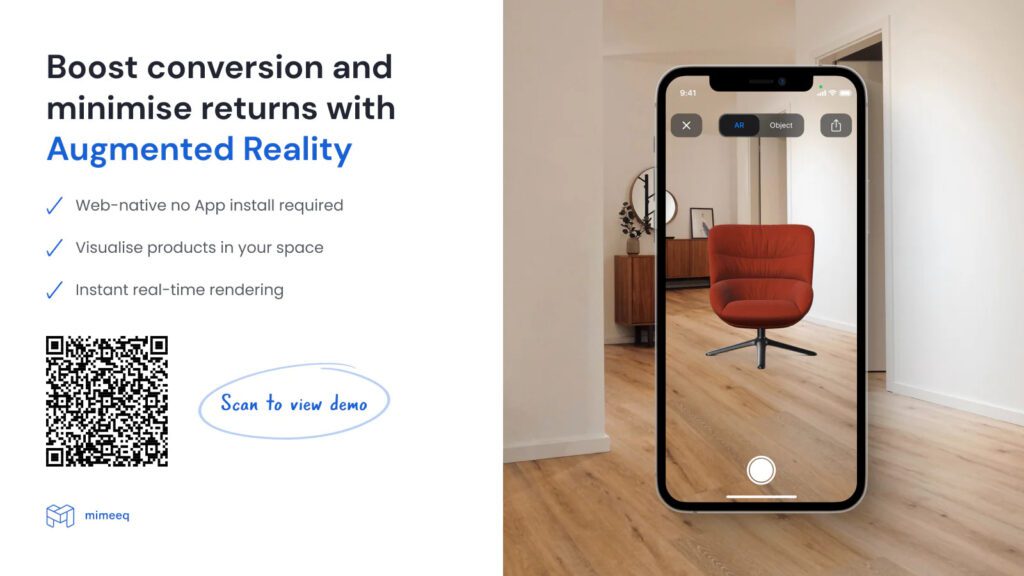
The product pages are where customers transform from browsers to actual purchasers. Ideal optimization of these pages serves as a key method to boost conversions. Let’s begin with descriptive product titles that contain appropriate keywords. For example, instead of “Dining Table,” use “Modern Wooden Extendable Dining Table – Seats 6 to 8”.
The display of high-quality images that can be zoomed in remains crucial for presenting furniture products to customers. You must present your products from different perspectives and display close-ups of textures and usage shots of furniture objects in real environments. The research conducted by Etsy revealed that product photo quality ranked as the key factor influencing 90% of shoppers when making their purchase decisions.

In addition to that, let’s create product descriptions with thoughtful content that presents design elements, material information, and functional space benefits. Bullet points should display crucial features to help viewers quickly scan the content. Your descriptions must contain all required dimensions, care instructions, and any customization options available.
The trustworthiness of a business depends greatly on positive customer reviews. Your buyers should be strongly encouraged to write reviews, and you should display those testimonials visibly on your product pages.
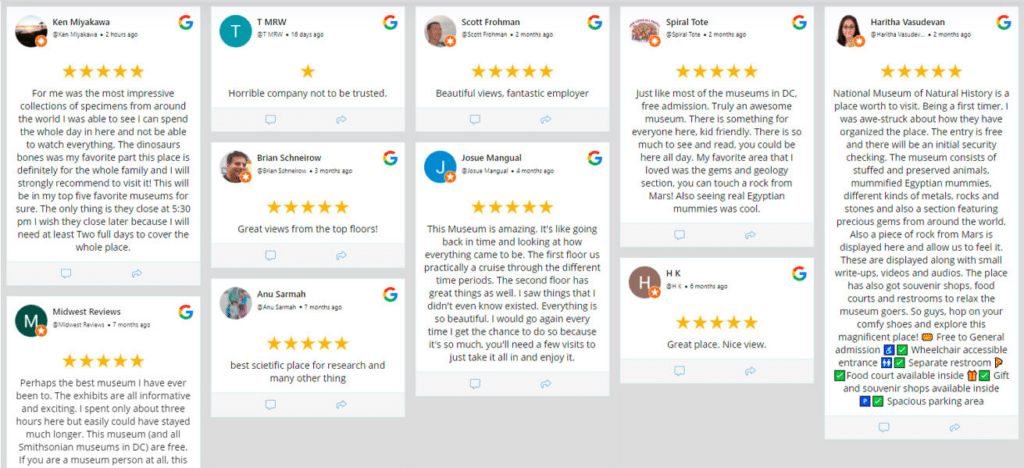
Lastly, your CTA buttons must be clearly visible and use action-oriented language. A/B tests different CTA placements and colors to find what works best for your store.
👉 Pro Tip: Maximize your revenue by upselling products relevant to the product customers are viewing.
With mobile commerce on the rise, optimizing your Shopify furniture store for mobile devices is no longer optional – it’s essential. In 2023, mobile devices reached $2.2 trillion, accounting for 60% of global e-commerce sales. Ensure your store theme is responsive and provides a smooth experience across all screen sizes.
For mobile design purposes, one must focus on simplicity and speed. Load times can be shortened by compressing images, although the quality remains the same. A lazy loading system should be implemented to enhance image loading speed. A clear, easy-to-read font selection should accompany buttons designed with sufficient size to fit small touchscreens.
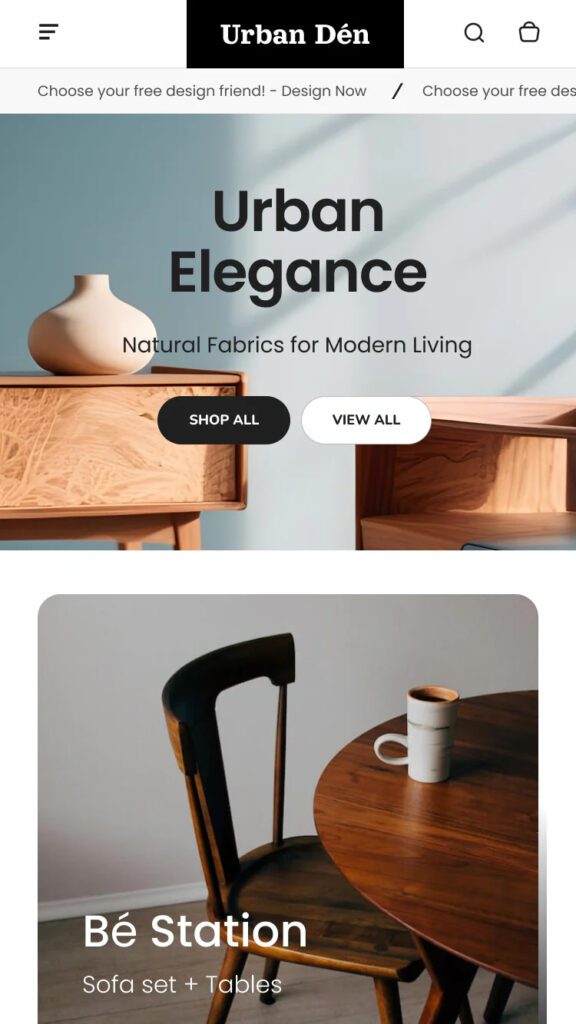
Pay attention to the difficulties people experience when shopping for furniture through mobile screen interfaces. You should establish easy-to-use filters and search functionality to let customers discover products more efficiently. Customers need to see product images without difficulty on small screens and should be able to activate detailed views through zoom functions.
Don’t forget to optimize your mobile checkout process. Minimize the number of form fields and offer guest checkout options to reduce friction. Implement mobile-friendly payment options like Apple Pay or Google Pay to streamline purchases.
Bringing traffic to your store isn’t enough – you need to increase order value to maximize revenue. One of the most effective ways to do this is using Shopify AI-powered product recommendations that suggest relevant, high-converting items based on customer behavior. Instead of showing random products, AI analyzes browsing history, past purchases, and cart contents to offer smart suggestions that feel natural rather than pushy.
However, product recommendations alone won’t maximize revenue. The best moment to encourage additional purchases is during checkout – when customers have already decided. This is where many Shopify stores miss out, relying on intrusive pop-ups or irrelevant upsells that feel forced.
Instead of guessing what customers might want, BOGOS.io Free Gift & Bundle lets you place strategic, personalized offers at checkout without disrupting the buying experience.
With BOGOS.io Free Gift & Bundle, you can:
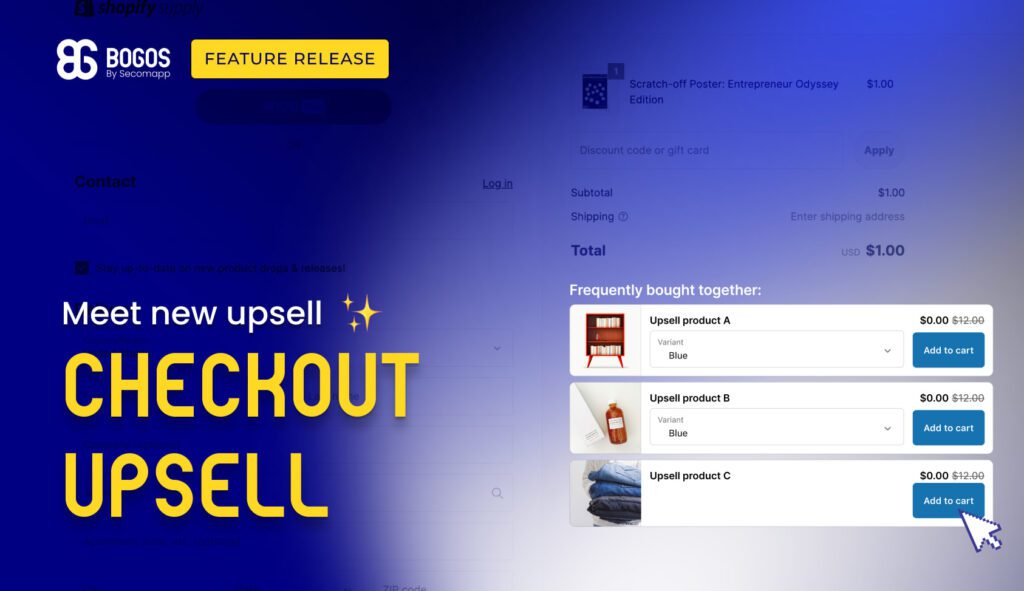
BOGOS also offers an advanced feature for upselling by matching product variants. When customers choose a particular variant, like the M-size T-shirt, the upsell suggestions will automatically apply to that variant. Moreover, you will have complete control over upsell content and visual design, allowing you to maintain brand integrity while creating more attractive upsell proposals.
It’s important to note that Shopify only allows checkout edits on Shopify Plus. While BOGOS Checkout Upsell is available for all merchants to set up and customize, only Shopify Plus users can activate upsells at checkout. This makes it a must-have tool for high-volume stores looking to scale revenue with targeted checkout promotions.
Get this app now: BOGOS.io Free Gift BOGO Bundle
Pricing Plans:
All plans include unlimited offers, advanced customization, and live chat support, with a 7-day free trial to test features before committing.
Search Engine Optimization (SEO) functions as a crucial system through which Shopify furniture stores can attract organic website visitors. Begin by researching search terms that your desired customers actively seek on the Internet. Use these keywords naturally in your product titles, descriptions, and metadata.
Create unique, informative content for each product page to avoid duplicate content issues. Consider adding a blog to your store where you can share furniture styling tips, care guides, and trends in home decor. This not only helps with SEO but also positions your store as an authority in the furniture niche.
Your site must have an optimized structure for easier crawlability and intuitive navigation. Your website URLs should contain keywords to describe page contents accurately. For example, “www.yourstore.com/dining-room/modern-extendable-table,” rather than random characters.
SEO optimization also requires attention to technical aspects. Fast site loading speed, mobile responsiveness, and HTTPS encryption must be present. Adding descriptive alt text to images helps accessibility while boosting SEO through accurate descriptions of the furniture products.
You should establish quality backlinks by collaborating with interior design blogs, home improvement websites, and local businesses. According to a study by Backlinko, pages with more backlinks tend to rank higher in Google search results.
In conclusion, building successful Shopify furniture stores in 2025 hinges on the right blend of strategy, design, and innovative tools to stay ahead of the curve. I hope you find this blog post helpful in launching or scaling your online furniture business – now it’s time to take the leap and create a truly shining store!
The basic steps to starting your Shopify furniture store are to create an account, pick an appropriate theme, upload your products with compelling descriptions and images, and select payment options and shipping methods.
Use high-quality images, detailed descriptions, and consider integrating AR features to help customers visualize products in their space.
Optimize images, minimize heavy scripts, and choose a fast, responsive theme to enhance site performance.
Use Shopify’s built-in inventory management system to track stock levels, set up alerts for low stock, and manage product variants efficiently.


Offering free gifts directly at checkout is a powerful last-minute conversion strategy that can increase average order value and...

Does your BFCM sales spike quickly disappear, leaving you with a list of one-time buyers who never return? That’s...

We know how tough it is to make your voice heard during the chaos of BFCM, where every brand...
